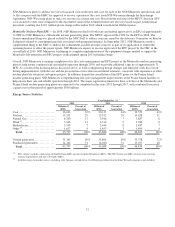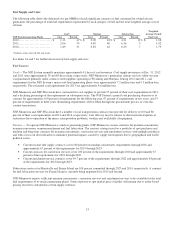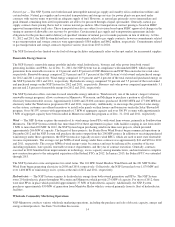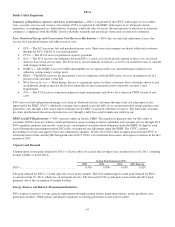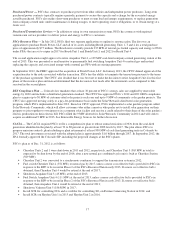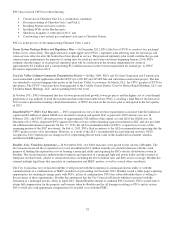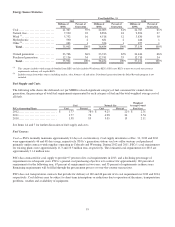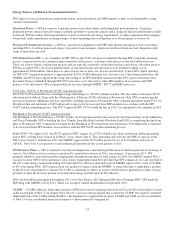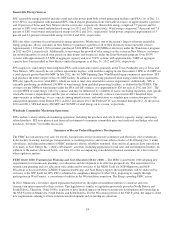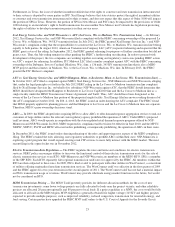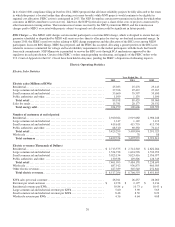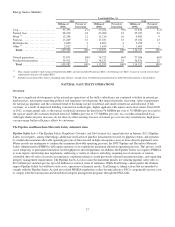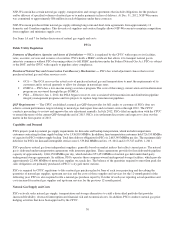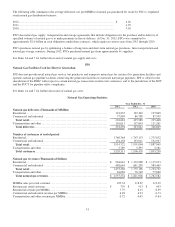Xcel Energy 2012 Annual Report Download - page 32
Download and view the complete annual report
Please find page 32 of the 2012 Xcel Energy annual report below. You can navigate through the pages in the report by either clicking on the pages listed below, or by using the keyword search tool below to find specific information within the annual report.
22
Energy Sources and Related Transmission Initiatives
SPS expects to use existing electric generating stations, power purchases and DSM options to meet its net dependable system
capacity requirements.
Purchased Power — SPS has contracts to purchase power from other utilities and independent power producers. Long-term
purchased power contracts typically require a periodic payment to secure the capacity and a charge for the associated energy actually
purchased. SPS also makes short-term purchases to meet system load and energy requirements, to replace generation from company-
owned units under maintenance or during outages, to meet operating reserve obligations or to obtain energy at a lower cost.
Purchased Transmission Services — SPS has contractual arrangements with SPP and regional transmission service providers,
including PSCo, to deliver power and energy to its native load customers, which are retail and wholesale load obligations with
terms of more than one year.
SPS Transmission NTC — As a member of SPP, SPS accepts NTCs for projects identified through SPP’s reliability planning
process, transmission service, generator interconnection study process, economic study process or the load addition process.
These are all new electric transmission projects and are typically a portfolio of transmission lines and electric substation projects.
SPS has accepted NTCs for several hundred miles of transmission line and substations at an estimated capital cost of
approximately $800 million. These projects span several years to plan, site, procure and develop. Typical SPS capital spending
for SPP NTC transmission projects is approximately $150 to $200 million per year, but may vary. Under their jurisdictions, the
NMPRC and PUCT have approved the siting and routing of all SPP identified transmission line NTC projects that have been
presented. Projects identified through SPP NTCs may have costs allocated to other SPP members in accordance with SPP
policies. Costs allocated to SPS are permissible for recovery through NMPRC, PUCT and FERC processes.
TUCO Inc. (TUCO) to Woodward 345 KV transmission line
The TUCO to Woodward District extra high voltage interchange is a 345 KV transmission line. This line connects the major TUCO
substation near Lubbock, Texas with the Oklahoma Gas & Electric (OGE) substation in Woodward, Okla. SPS is constructing the
line to just inside the Oklahoma state line, and OGE is building from there to Woodward. SPS’ estimated investment in the TUCO to
Woodward line and substation is $185 million and is expected to be recovered from SPP members in accordance with the SPP
OATT and the ratemaking process. The PUCT approved SPS’ CCN to build the line in 2012. It is anticipated to be complete in 2014.
Hitchland to Woodward 345 KV transmission line
The Hitchland to Woodward line is a 345 KV double circuit transmission line and associated substation facilities in the Oklahoma
and Texas Panhandle. SPS is building the first 30 miles from Hitchland towards Woodward and OGE is completing the line from
there to Woodward. SPS’ estimated investment for the Hitchland to Woodward line and substation is $56 million and is expected
to be recovered from SPP members in accordance with the SPP OATT and the ratemaking process.
Jones CCN — In August 2011, the PUCT approved SPS’ request for a CCN to build a gas-fired combustion turbine generating
unit at SPS’ existing Jones Station in Lubbock, Texas (Jones Unit 4). This generating unit will add 168 MW of capacity to the
SPS service territory. In February 2012, the NMPRC approved the CCN with a projected cost of $118 million, inclusive of
AFUDC. Jones Unit 4 is expected to reach commercial operation in the second quarter of 2013.
SPS Resource Plans — SPS is required to develop and implement a renewable portfolio plan in which ten percent of its energy to
serve its New Mexico retail customers is produced by renewable resources in 2011, increasing to 15 percent in 2015. SPS
primarily fulfills its renewable portfolio requirements through the purchase of wind energy. In 2009, the NMPRC granted SPS a
variance to allow SPS to delay meeting its solar energy requirement until 2012 provided that SPS compensates for any shortfall of
the 2011 solar energy requirement during 2012 through 2014. SPS executed and received NMPRC approval for a total of 50 MW
of PV solar energy PPAs. SPS requested and was granted a variance from the NMPRC to extend the time to implement a portion
of the diversity requirements to January 2014. SPS is continuing its efforts to acquire viable biomass generation or make a biogas
purchase to meet the diversity portion of its renewable energy portfolio plan in New Mexico.
SPS solicited public participation throughout 2011 in its New Mexico 2012 Integrated Resource Planning (IRP). SPS made the
IRP filing with NMPRC in July 2012, which was accepted without modification in September 2012.
CSAPR — CSAPR addresses long range transport of PM and ozone by requiring reductions in SO2 and NOx from utilities located
in the eastern half of the U.S. In August 2012, the D.C. Circuit issued an opinion that vacated the CSAPR, but required continued
implementation of the CAIR pending the EPA’s development of a replacement program. CSAPR and CAIR are discussed further
at Note 13 to the consolidated financial statements — Environmental Contingencies.


